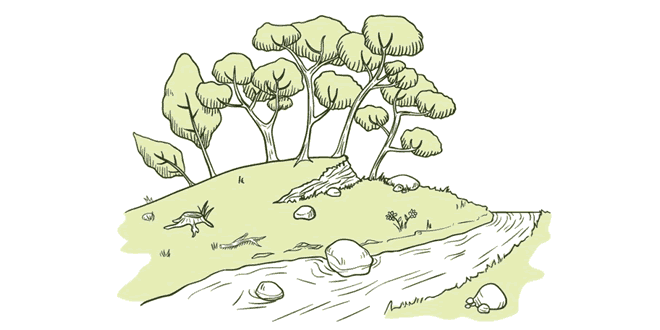Question: Why is the Godavari often referred to as the ‘Dakshin Ganga’? Write a note on the river Godavari and its tributaries.
Answer: The Godavari is the largest Peninsular river. It has a length of 1500 km. It has the largest drainage basin amongst the Peninsular rivers. Its drainage basin covers parts of Maharashtra, Madhya Pradesh, Orissa and Andhra Pradesh. On account of its dominating length and the extent of area it covers, the Godavari is known as the ‘Dakshin Ganga’. The Godavari rises from the slopes of the Western Ghats in the Nasik district of Maharashtra. It flows eastwards and drains into the Bay of Bengal. Nearly half of its drainage basin lies in Maharashtra.The Godavari is joined by large tributaries – the Wain Ganga, the Penganga and the Manjra. The Purna, the Wardha and the Pranhita are its other tributaries.
Question: Define the term ‘drainage’. Describe different drainage patterns.
Answer: The term ‘drainage describe the river system of an area. The streams within a drainage basin (the area drained by a single river system) form certain pattern which are given below:
- Dendritic pattern: Dendritic drainage systems (from Greek δ, dendrites, “of or pertaining to a tree”) are the most common form of drainage system. In a dendritic system, there are many contributing streams (analogous to the twigs of a tree), which are then joined together into the tributaries of the main river (the branches and the trunk of the tree, respectively). They develop where the river channel follows the slope of the terrain. Dendritic systems form in V-shaped valleys; as a result, the rock types must be impervious and non-porous.
- Trellis drainage pattern: The geometry of a trellis drainage system is similar to that of a common garden trellis used to grow vines. As the river flows along a strike valley, smaller tributaries feed into it from the steep slopes on the sides of mountains. These tributaries enter the main river at approximately 90 degree angle, causing a trellis-like appearance of the drainage system. Trellis drainage is characteristic of folded mountains, such as the Appalachian Mountains in North America and in the north part of Trinidad.
- Rectangular drainage pattern: Rectangular drainage develops on rocks that are of approximately uniform resistance to erosion, but which have two directions of joining at approximately right angles or 90 degrees. The joints are usually less resistant to erosion than the bulk rock so erosion tends to preferentially open the joints and streams eventually develop along the joints. The result is a stream system in which streams consist mainly of straight line segments with right angle bends and tributaries join larger streams at right angles.
- Radial drainage pattern: In a radial drainage system, the streams radiate outwards from a central high point. Volcanoes usually display excellent radial drainage. Other geological features on which radial drainage commonly develops are domes and laccoliths. On these features the drainage may exhibit a combination of radial patterns.
Question: Write a note on the Indus Drainage System.
Answer: The Indus is one of the longest rivers of the world. The river Indus rises in Tibet, near lake Mansarovar. Flowing west, it enters India in the Ladakh district of Jammu and Kashmir. A spectacular gorge formed by the Indus marks this part. Several tributaries – the Zaskar, the Nabra, the Shyok and the Hunza – join the Indus in the Kashmir region. The Indus flows through Baltistan and Gilgit and emerges from the mountains at Attock. The tributaries of the Indus – the Jhelum, the Chenab, the Ravi, the Beas and the Satluj – flow partly through Kashmir and Himachal Pradesh and mainly through Punjab. They join together to enter the Indus near Mithankot in Pakistan. The Indus then flows southwards and eventually reaches the Arabian Sea, east of Karachi. The Indus has a total length of 2900 km. The Indus plain has a very gentle slope. A little over one third of the Indus basin lies in India in the states of Jammu and Kashmir, Himachal Pradesh and Punjab. Major part of its basin lies in Pakistan.
Question: Write a note on the Ganga Drainage System.
Answer: The Ganga is the longest and the most important river system of India. It has a total length of over 2500 km. Nearly the entire river basin of the Ganga lies in India with a part of its lower course and delta in Bangladesh. The headwaters of the Ganga is called the ‘Bhagirathi’. It is fed by the Gangotri Glacier. It is joined by the Alaknanda at Devaprayag in Uttarakhand. At Haridwar, the Ganga emerges from the mountains and enters the plains. The Ganga is joined by a large number of tributaries. The Yamuna, a right-bank tributary of the Ganga, rises from the Yamunotri Glacier, flows parallel to the Ganga and joins it at Allahabad. The Ghaghra, the Gandak, the Kosi and the Sarda are the left-bank tributaries of the Ganga. The other right bank tributaries of the Ganga – the Chambal, the Betwa and the Son – come from the Peninsular uplands. The Ganga and its tributaries form a major portion of the northern plains. On account of water availability and fertile soil, it is the most important agricultural region of India. The Ganga develops large meanders in the plains. The Ganga flows eastwards with the increased volume up to Farakka in West Bengal. The river bifurcates here. Its distributary, the Bhagirathi-Hooghly, flows through the deltaic plains to the Bay of Bengal. The mainstream flows southwards into Bangladesh. Here it is known as Padma. It is joined by the Brahmaputra. Further downstream it is known as Meghna. Together they form the Ganga- Brahmaputra Delta, also known as Sunderbans delta. It is the world’s largest and fastest growing delta.
 Class Notes NCERT Solutions for CBSE Students
Class Notes NCERT Solutions for CBSE Students



